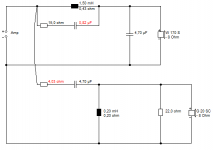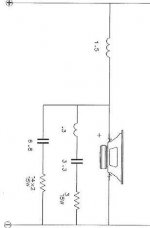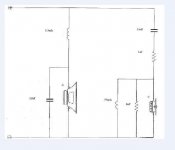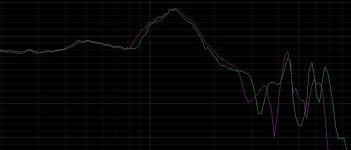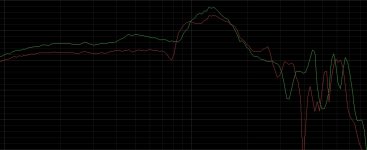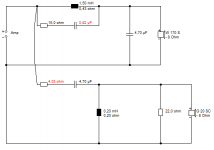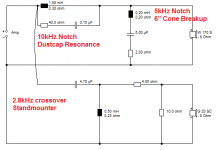Trying to design a minimum budget speaker is a good idea, but I think, the cabinet should also be kept as simple as possible to facilitate the build. That means no edge rounding and a classic plastic tube as vent.
I would save $11 on the drivers and invest the amount in a uncompromising crossover:
The Madisound Speaker Store
The Madisound Speaker Store
The Peerless SDS164 needs more volume than the SF, around 1 cu ft should do.
I would save $11 on the drivers and invest the amount in a uncompromising crossover:
The Madisound Speaker Store
The Madisound Speaker Store
The Peerless SDS164 needs more volume than the SF, around 1 cu ft should do.
sreten,
As I want to come to terms with SE, reproducing your simulation would be a good place to start. I have to admit, I don't see how to get an elliptical in third order. What algorithms are you using? I would love to plug them into my spreadsheet I use for crude first pass and drop them into SPICE to understand.
Of course, one has to build the crossover to see how close, but SE is usually darn close. What were the values you came up with? I found smoothing the ripple in the crossover range to be a bit more challenging than the sim suggested. Padding the tweeter became a real pain as I kept getting bigger and bigger midrange problems.
Assuming moving from second to third order, and the allowable slide to 2K, what advantages do you see in the elliptical over a Butterworth? The difference in initial rolloff is only within a few hundred Hz. Kind of where Small left off, "no obvious advantage"
Cheap drivers sure are difficult to use. This is part of what I was trying to show. Read the Santori threads and they make you drool.
As I want to come to terms with SE, reproducing your simulation would be a good place to start. I have to admit, I don't see how to get an elliptical in third order. What algorithms are you using? I would love to plug them into my spreadsheet I use for crude first pass and drop them into SPICE to understand.
Of course, one has to build the crossover to see how close, but SE is usually darn close. What were the values you came up with? I found smoothing the ripple in the crossover range to be a bit more challenging than the sim suggested. Padding the tweeter became a real pain as I kept getting bigger and bigger midrange problems.
Assuming moving from second to third order, and the allowable slide to 2K, what advantages do you see in the elliptical over a Butterworth? The difference in initial rolloff is only within a few hundred Hz. Kind of where Small left off, "no obvious advantage"
Cheap drivers sure are difficult to use. This is part of what I was trying to show. Read the Santori threads and they make you drool.
Box size should be 13 liters.
Thanks for Michael C. for posting size, etc. http://www.diyaudio.com/forums/multi-way/227018-canned-crossover-design-what-next-4.html
One thing that is very nice about the SF, it handles a lot of power, something to do the short throw.
Thanks for Michael C. for posting size, etc. http://www.diyaudio.com/forums/multi-way/227018-canned-crossover-design-what-next-4.html
OK, now you are going to make me put them in a box with my style of large radius baffle and see if I can tweak the top end a tad more.
One thing that is very nice about the SF, it handles a lot of power, something to do the short throw.
Trying to design a minimum budget speaker is a good idea, but I think, the cabinet should also be kept as simple as possible to facilitate the build. That means no edge rounding and a classic plastic tube as vent.
I would save $11 on the drivers and invest the amount in a uncompromising crossover:
The Madisound Speaker Store
The Madisound Speaker Store
The Peerless SDS164 needs more volume than the SF, around 1 cu ft should do.
Agree totally on classic vent. Out the rear. I would argue the value of the round-over. It really is significant. If you don't have a router that can sling a 3/4 bit, you can do it with a rasp and sand paper. Seriously, it can make a very big difference. I am starting on a set as soon as I do the layout today from 3/4 particle board. Doug is building another set so we will be able to A/B them. I am betting I can squeeze $50 out of the build in the box and improve the top end at the same time. The total cost was quite a bit higher than I expected when I added it up.
The SF woofer is hard to beat for it's low end and small box. These are only 13L. That is a big attraction and was the reason to do this in the first place. They play pretty loud without getting ugly. The Peerless is definitely one to look at if planning on a AV with a sub and high crossover to a sealed cabinet. (my favorite configuration). I am not sure it could match the bass of the SF stand alone. Model it and see what it says.
I think the Dayton tweet is hard to better for the price. I have used that Vifa and I consider it to be vile. It is useless below 3K and I would not use it above 3K either. Not that there are not worse. I would say it is the most significant factor that got me to move to Seas drivers in the $50 and up range. I used to think it was more a matter of good crossover design, but now I understand the difference is in the tweeter too.
$10 more for each crossover may or may not get you much further. You can save about $5 by using electrolytics on the woofer for sure. Not enough to go third order and not enough for a LC notch. Half way there? The Peerless has the same breakup issues, so no savings there.
By all means, at least work up the alternatives on paper!
I think you need to start again, tvrgeek.
The bass driver is Silver Flute W17RC38-08 6-1/2" Wool Cone. Main breakup resonance at 4.5kHz.
Lynn Olson is the man here:
What I see here is too much bafflestep and heavy bass, too low a crossover (what, 1.5kHz?), and no attention to phase alignment above 5kHz.
I'll skip the elliptical/Cauer stuff here along with all the other gibberish I have read in this thread, and just do a simple tank on the bass and crossover at 3kHz, since we are keeping it simple. I think that will work much better. Red components are driver dependant, but 0.82 will be about right for the silver flute 4.5 kHz peak.
The bass driver is Silver Flute W17RC38-08 6-1/2" Wool Cone. Main breakup resonance at 4.5kHz.
Lynn Olson is the man here:
When working with rigid-cone drivers, there are some hard choices to make: if you lower the crossover frequency to minimize driver coloration, tweeter IM distortion skyrockets, resulting in raspy, distorted high frequencies at mid-to-high listening levels.
If you raise the crossover frequency to improve the sound of the tweeter, the rigid-driver breakup creeps in, resulting in a forward, aggressive sound at moderate listening levels, and complete breakup at high levels. (Unlike paper cones, Kevlar, metal, and carbon fibers do not go into gradual breakup.)
With the drivers we have today, the best all-around compromise is a 2nd, 3rd, or 4th-order (12-24dB/Oct.) crossover with an additional NOTCH filter tuned to remove the most significant HF resonance of the midbass driver.
The crossover I ended up with is a second order electrical. Not quite symmetrical. Woofer is a 3.3mH and 12uF. Q is about 1. Tweeter 15uF, .75mH with a 1 & 8 Ohm L Pad.
What I see here is too much bafflestep and heavy bass, too low a crossover (what, 1.5kHz?), and no attention to phase alignment above 5kHz.
I'll skip the elliptical/Cauer stuff here along with all the other gibberish I have read in this thread, and just do a simple tank on the bass and crossover at 3kHz, since we are keeping it simple. I think that will work much better. Red components are driver dependant, but 0.82 will be about right for the silver flute 4.5 kHz peak.
Attachments
System7.
Dead on analysis in all accounts. I agree totally with what is not optimum. When I say how bad they sounded to me, I am used to at least mid-line Seas or Dayton RS drivers with the best crossover I could design at the time. Total cost is usually several times this project. This project is to build something CHEAP. With that in mind, they are pretty good. I know they can be better. I for sure have built worse in the past and have heard many a speaker in the store far worse. Here is no way these drivers will be a $1800 Vanderstein killer. Can they beat anything built in a store under $400 a pair? They probably do now in the first box. Not good enough.
Note, it LOOKS like too much baffle step, ( 2.7 originally) but in reality the 3.3mH was needed to smooth the midrange in Dougs box. The actual measured response is within a couple dB right through until the tweeter gets ragged above 5K or so. They are not bass heavy. Reducing it always have me a lifeless hole in the mids. Think the opposite extremist of an old JBL. As I had 2.7's on hand, you better believe I kept trying to use them and not spend $60 out of pocket on the 3.3's!
Starting with the SF, I picked a tweeter that could cross as low as possible. I usually target about 2600. This one is starting at 1500. Turns out it is just plain too low. I have to do something else.
I selected a second order crossover as it is CHEAP. Not optimum. We all know that. I am trying to not have to add additional notch filters and contours as they are expensive. I may fail at this.
So, my second box in glue-up now is cheap PB. That saves considerable from Doug's box. (assuming purchase of new sheet goods, not building green by using waste pieces). The box is square so it could be made with a hand saw and router. No beveled cuts. Cheap beginner fab.
The box follows what I have found to be most successful. 3/4 radius on all corners. By removing the tweeter from the face plate, it is almost an inch and a half closer to the woofer and the short waveguide will increase distortion and further help close off-axis. Port is plastic pipe, exit end radiused 3/4 inch. If I can get the spacing perfect, I have a trick to set the inside end of the port in a center brace and radius it. Looks like I'll miss that this time. The box is a tad larger internal than the first ones hitting abort 14L effective. Model suggests I can keep below 1dB ripple and have the correct size that if the port was pluged, you hit the THX 80 Hz dead on.
Now, I can bet I am going to have to put a contour to tame the tweeter with a wave guide. At least the frequencies are high so components are not really expensive.
I have a SF where I doped the cone with a thin smear of RTV. TS parameters look very good and "tap test" shows quite a difference especially in the dust cap. I will know if I have lowered the Q of the breakup when I get it into the box. Worse case is it gets mushy and sounds like an old soft poly cone. Then I have failed. Another trick is to remove the dust cap and carve a phase plug. Rather drastic but if the doping failed, I'll try that. When I was playing with Fostex and Fountek full ranges, I was very surprised to see how detrimental the dust cap can be. Can a little RTV let my push the crossover to 1800? I bet 2K is dreaming.
Then I will find out how high I can push the woofer I'll know if I have to spend the big bucks on a second coil in the LP section or a notch. Dropping $30 coils here than there gets really expensive and will fail the budget limit out of the gate.
The goal is to see what a well done really cheap system could be. We found the SF to be better than it's lowly $30 price, so what can we do with it? Knowing all about it's breakup, first choice is the lowest possible crossover. What tweeter can get that low? Cheap, I know of only one. Parts are set. Now do the best you can cheap. First pass said we were on the right track; the SF behaving very well at its low crossover. The tweeter was screaming in agony and it was just a tad bright.
I would have left it there as a set in my garage and moved on. Unfortunately budget does not let me move on to the Santoris I am drooling over or playing with ribbons. So, what can I do here really cheap I have not played with before? Wave guides for one. I have not use thin cheap PB for boxes in many years. And I am still learning the modern simulation tools.
I was hoping to get some of the other experienced builders here to toss in viable options that pass the budget limit with these drivers. Beat the combo to death as it were. Do me better. A simple week or so I put in is no where enough for a good design. Lets see some real alternatives? Drivers are only $50 a side, and most of us have enough lumber and crossover parts to mock things up. Lets see something better CHEAPER.
I hope our discussion helps first time builders. Cheap is good and it does not preclude good engineering. Understanding compromises and limits to the drivers is a valuable lesson. Understanding how it may take $100 in extra crossover to fix a $30 woofer when you could buy a $60 woofer is a valuable lesson.
My approach: Do a box that helps with the hot top by better managing diffraction.
Mount the tweeter to improve efficiency so by lowering the distortion.
Reduce driver spacing to help off-axis lobing.
Dope the cone to lower the breakup Q hopefully without lowering the frequency to allow a small shift up in crossover, reducing cost of the HP coil and reducing midrange distortion.
I hope to have in-box raw measurements by tonight depending on the length of the honey-do list. I'll post them with the baffle design when they are ready so others can play with the models.
Dead on analysis in all accounts. I agree totally with what is not optimum. When I say how bad they sounded to me, I am used to at least mid-line Seas or Dayton RS drivers with the best crossover I could design at the time. Total cost is usually several times this project. This project is to build something CHEAP. With that in mind, they are pretty good. I know they can be better. I for sure have built worse in the past and have heard many a speaker in the store far worse. Here is no way these drivers will be a $1800 Vanderstein killer. Can they beat anything built in a store under $400 a pair? They probably do now in the first box. Not good enough.
Note, it LOOKS like too much baffle step, ( 2.7 originally) but in reality the 3.3mH was needed to smooth the midrange in Dougs box. The actual measured response is within a couple dB right through until the tweeter gets ragged above 5K or so. They are not bass heavy. Reducing it always have me a lifeless hole in the mids. Think the opposite extremist of an old JBL. As I had 2.7's on hand, you better believe I kept trying to use them and not spend $60 out of pocket on the 3.3's!
Starting with the SF, I picked a tweeter that could cross as low as possible. I usually target about 2600. This one is starting at 1500. Turns out it is just plain too low. I have to do something else.
I selected a second order crossover as it is CHEAP. Not optimum. We all know that. I am trying to not have to add additional notch filters and contours as they are expensive. I may fail at this.
So, my second box in glue-up now is cheap PB. That saves considerable from Doug's box. (assuming purchase of new sheet goods, not building green by using waste pieces). The box is square so it could be made with a hand saw and router. No beveled cuts. Cheap beginner fab.
The box follows what I have found to be most successful. 3/4 radius on all corners. By removing the tweeter from the face plate, it is almost an inch and a half closer to the woofer and the short waveguide will increase distortion and further help close off-axis. Port is plastic pipe, exit end radiused 3/4 inch. If I can get the spacing perfect, I have a trick to set the inside end of the port in a center brace and radius it. Looks like I'll miss that this time. The box is a tad larger internal than the first ones hitting abort 14L effective. Model suggests I can keep below 1dB ripple and have the correct size that if the port was pluged, you hit the THX 80 Hz dead on.
Now, I can bet I am going to have to put a contour to tame the tweeter with a wave guide. At least the frequencies are high so components are not really expensive.
I have a SF where I doped the cone with a thin smear of RTV. TS parameters look very good and "tap test" shows quite a difference especially in the dust cap. I will know if I have lowered the Q of the breakup when I get it into the box. Worse case is it gets mushy and sounds like an old soft poly cone. Then I have failed. Another trick is to remove the dust cap and carve a phase plug. Rather drastic but if the doping failed, I'll try that. When I was playing with Fostex and Fountek full ranges, I was very surprised to see how detrimental the dust cap can be. Can a little RTV let my push the crossover to 1800? I bet 2K is dreaming.
Then I will find out how high I can push the woofer I'll know if I have to spend the big bucks on a second coil in the LP section or a notch. Dropping $30 coils here than there gets really expensive and will fail the budget limit out of the gate.
The goal is to see what a well done really cheap system could be. We found the SF to be better than it's lowly $30 price, so what can we do with it? Knowing all about it's breakup, first choice is the lowest possible crossover. What tweeter can get that low? Cheap, I know of only one. Parts are set. Now do the best you can cheap. First pass said we were on the right track; the SF behaving very well at its low crossover. The tweeter was screaming in agony and it was just a tad bright.
I would have left it there as a set in my garage and moved on. Unfortunately budget does not let me move on to the Santoris I am drooling over or playing with ribbons. So, what can I do here really cheap I have not played with before? Wave guides for one. I have not use thin cheap PB for boxes in many years. And I am still learning the modern simulation tools.
I was hoping to get some of the other experienced builders here to toss in viable options that pass the budget limit with these drivers. Beat the combo to death as it were. Do me better. A simple week or so I put in is no where enough for a good design. Lets see some real alternatives? Drivers are only $50 a side, and most of us have enough lumber and crossover parts to mock things up. Lets see something better CHEAPER.
I hope our discussion helps first time builders. Cheap is good and it does not preclude good engineering. Understanding compromises and limits to the drivers is a valuable lesson. Understanding how it may take $100 in extra crossover to fix a $30 woofer when you could buy a $60 woofer is a valuable lesson.
My approach: Do a box that helps with the hot top by better managing diffraction.
Mount the tweeter to improve efficiency so by lowering the distortion.
Reduce driver spacing to help off-axis lobing.
Dope the cone to lower the breakup Q hopefully without lowering the frequency to allow a small shift up in crossover, reducing cost of the HP coil and reducing midrange distortion.
I hope to have in-box raw measurements by tonight depending on the length of the honey-do list. I'll post them with the baffle design when they are ready so others can play with the models.
Nearfield testing of SF:
Note that these are two different samples, and there will be variation one to another.
Dopping the cone reduced the efficiency by about a dB. Expected (more mass) but not good.
It pretty much killed off the 5700 and 6600 resonances. Good but probably not important.
It did nothing to the 4400 primary breakup. Disappointing but not surprised.
By adding foam blocks, I believe the primary culprit is the dustcap where the plateau across 2 to 3K is the cone edge.
I could remove the dustcap and add a plug.
I could slit and re-dope the dustcap to raise its breakup frequency.
I could increase the stiffness of the cone in hopes to raise the breakup frequency.
This requires another cup of coffee. Any other ideas?
Note that these are two different samples, and there will be variation one to another.
Dopping the cone reduced the efficiency by about a dB. Expected (more mass) but not good.
It pretty much killed off the 5700 and 6600 resonances. Good but probably not important.
It did nothing to the 4400 primary breakup. Disappointing but not surprised.
By adding foam blocks, I believe the primary culprit is the dustcap where the plateau across 2 to 3K is the cone edge.
I could remove the dustcap and add a plug.
I could slit and re-dope the dustcap to raise its breakup frequency.
I could increase the stiffness of the cone in hopes to raise the breakup frequency.
This requires another cup of coffee. Any other ideas?
TVR, my personal opinion is that to add a notch or convert to Cauer filter is not difficult.
Just a single inductor in the shunt path of your lowpass. Like i did with the crossover in my visaton build. It worked well in my case (2.2mH series, 5uF and ~50uH in the shunt path) and despite what System7 reckons, it actually improved phase. I wound the inductor on an M10 or 3/8 unf bolt, something like 40 turns of 22 gauge. DCR isn't a huge issue here, i got ~0.5 Ohm, which tames the notch a touch, but also the rise after the stopband.
The highpass is perhaps another story.
Just a single inductor in the shunt path of your lowpass. Like i did with the crossover in my visaton build. It worked well in my case (2.2mH series, 5uF and ~50uH in the shunt path) and despite what System7 reckons, it actually improved phase. I wound the inductor on an M10 or 3/8 unf bolt, something like 40 turns of 22 gauge. DCR isn't a huge issue here, i got ~0.5 Ohm, which tames the notch a touch, but also the rise after the stopband.
The highpass is perhaps another story.
Last edited:
mondo, my friend, I can do Cauer filters along with Mr. Zaph and the rest of them. But I don't think the man on the Clapham omnibus would know what I am talking about. And nor do most of the people here. 
My feeling is that a simple 15R/0.82uF tank/notch placed on the bass coil at 4.5kHz here will do 90% of the same phase and frequency response goodness for less bucks. Never underestimate the tank!
My feeling is that a simple 15R/0.82uF tank/notch placed on the bass coil at 4.5kHz here will do 90% of the same phase and frequency response goodness for less bucks. Never underestimate the tank!
Attachments
Quite right mondo; not difficult at all to add a notch. SOP for where performance is more important than budget. Done it many times myself ( I have used several Dayton RS 150's and 110's)
I still contend, an elliptical filter is of no real advantage as the steeper rolloff is only right at cutoff. An octave out, no difference. It requires a third order so is said but my understanding is a fourth. Not a budget design.
Don't know how the market is on your side of the pond, but over here, it is cheaper to buy ready made coils for PE than to buy bulk enameled wire. I don'd get it, but that is the way it is so I don;t wind my own coils. I unwind a few to get exact values of course.
So, I cut out the dust cap. It is very heavy. Eliminated the 4500 problem. Of course with a big hole, there are a few others. I have two approaches to a phase plug. The first is a piece of drain pipe is exactly the correct size, 1 1/2 inch. I will fill it with something and cut tapered slots to make a slotted plug. The second approach is gluing up a stack of MDF and turning it down. I don't have a lathe though. So, I roughed it out on the router and am going to see if I can make some sort of crude lathe and sand it to a nice bullet while it spins. Total guess on shape. All this is far cheaper in dollars than filters.
I still contend, an elliptical filter is of no real advantage as the steeper rolloff is only right at cutoff. An octave out, no difference. It requires a third order so is said but my understanding is a fourth. Not a budget design.
Don't know how the market is on your side of the pond, but over here, it is cheaper to buy ready made coils for PE than to buy bulk enameled wire. I don'd get it, but that is the way it is so I don;t wind my own coils. I unwind a few to get exact values of course.
So, I cut out the dust cap. It is very heavy. Eliminated the 4500 problem. Of course with a big hole, there are a few others. I have two approaches to a phase plug. The first is a piece of drain pipe is exactly the correct size, 1 1/2 inch. I will fill it with something and cut tapered slots to make a slotted plug. The second approach is gluing up a stack of MDF and turning it down. I don't have a lathe though. So, I roughed it out on the router and am going to see if I can make some sort of crude lathe and sand it to a nice bullet while it spins. Total guess on shape. All this is far cheaper in dollars than filters.
Hi,
I've no idea if a series baffle step inductor followed by a notch filter
set to 4.5KHz for the SF can be massaged into a viable x/o function,
by manipulation of the notch Q, however it is a very effective technique
in terms of component count if you can get it to work with a peaky driver.
x/o point of course also depends on how low the tweeter can go,
and what is good point to utilise its overall roll-off for x/o function.
rgds, sreten.
I've no idea if a series baffle step inductor followed by a notch filter
set to 4.5KHz for the SF can be massaged into a viable x/o function,
by manipulation of the notch Q, however it is a very effective technique
in terms of component count if you can get it to work with a peaky driver.
x/o point of course also depends on how low the tweeter can go,
and what is good point to utilise its overall roll-off for x/o function.
rgds, sreten.
Drill motor is your friend here.I don't have a lathe though. So, I roughed it out on the router and am going to see if I can make some sort of crude lathe and sand it to a nice bullet while it spins. Total guess on shape. All this is far cheaper in dollars than filters.
- Status
- This old topic is closed. If you want to reopen this topic, contact a moderator using the "Report Post" button.
- Home
- Loudspeakers
- Multi-Way
- Budget build results, SF-Dayton
